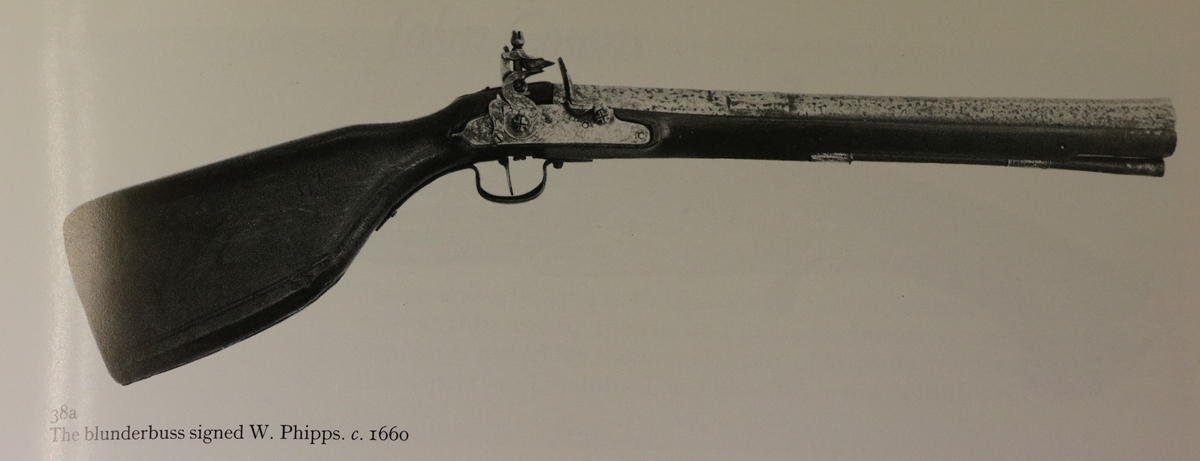Here is an interesting and very old blunderbuss – if it is as it seems it may be as early as the English Civil War (1642 – 1651) – certainly it is of a design that was current from about 1640 to 1670 at the latest as far as I can see – there can’t be many guns about from that date, so it may be something of a rarity and of significant historical importance – enough to keep one from ANY conjectural restoration work and anything but the most sensitive repairs ! Features that signify an early date are the general shape of the stock, the dog lock with flat plate and ‘teat’ tail, the sear pivoting on a vertical shaft, the barrel tang secured by a ‘nail’ from underneath, the ramrod pipe made from sheet and opened out to fix it and probably the key early feature – the cock secured by a post passing through the tumbler and pinned on the inside. I’m not sure about the proof marks – London was using standard marks at that period but Birmingham was still 150 years from opening its first ordinance proof house – anything made in Commonwealth controlled parts e.g London, would have used the Parliamentarian proof marks of a shield – I suspect that this has a private Birmingham proof mark along with the barrrel stamp E I T and another mark I cannot read.
Here are some photos ( taken with my travelling camera so not quite up to normal standard!) – I’d welcome any ideas, particularly on the initials on the barrel stamp – they look like E I I or perhaps E I T with a sun above. One possibility for the maker is Edmund Truelocke (working 1660 – 1680?) with a shop in London.
The lock is held in by 3 screws – an early feature.
Note absence of cock screw holding cock to tumbler – its pinned inside – see below.
Nail secures tang from underneath.
The trigger guard looks a little flimsy although they were often made of flat strip and screwed onto the wood at that date, not inset.
The trigger has been curled in a later way – a mistake.
There is a plain brass side plate that covers the whole flat – possibly original ?
From W Keith Neil and Backs ‘ Great British Gunmakers 1540 to 1740’. Note straight trigger and flat strip trigger guard. The three screws taht hold the lock are in the same places, but this one has a slightly later (?) cock fixing.











EIT = East India Trading? Would be nice.
It would, but the blunderbuss date is too early and it should be EIC! And not under the barrel.
Tim
Hi Tim.English lock 1640 to 1670, blunderbuss are unusual this early.the basic idea coming back to England from the low countries. (30 yr war).I haven’t got a copy but !For Commonwealth and Crown,
English Gunmaker of the seventeenth century .by John.S.Cooper, may be helpful. Also illustration of
these lock types in.Guns and Rifles of the world. by H.L Blackmore.
Hi Pete,
My source for the dating was primarily Keith Neil & Back- ‘Great British Gunmakers 1540 to 1740’ which illustrates several similar locks, and a blunderbuss by W Phipps dated to 1660 that has a later lock with a screw holding the cock on but is otherwise very similar. The other books don’t have a lot to say. It’s possible that the lock and barrel are not contemporary, but it looks ‘of a piece’for the most part. Probably my only reservation with it is the condition of the lock – its more or less without corrosion on the outside. In general it does look unworn so maybe that is OK?
(The 30 years War was 1618 to 1648 so could be made some time in the 1650s.)
Tim